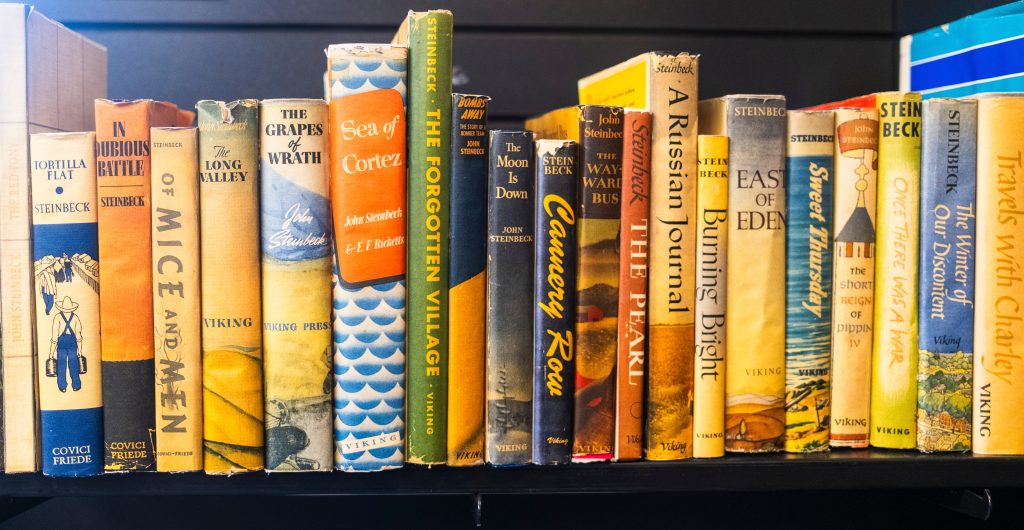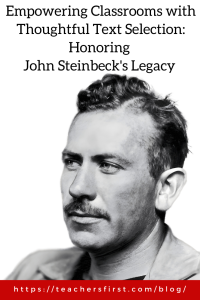
John Steinbeck is one of America’s greatest authors. His books expertly depict his time’s social and economic hardships and injustices, using compassionate writing to help readers develop empathy. Steinbeck is known for highlighting the fringes of society and forcing his readers to confront realities they would rather hide from. This is one reason he won the Nobel Peace Prize in literature in 1962. To honor John Steinbeck so near his birthday (February 27, 1902), it is only fitting to discuss text choice.
The Evolution of Text Selection in Education
For years English teachers have debated on what books to read in class. Educational Standards are moving away from “all 9th graders must read Romeo and Juliet” to something akin to Minnesota Department of Education, 2020 Minnesota Academic Standards in English Language Arts, Reading Standard R4: “Read critically to comprehend, interpret, and analyze themes and central ideas in complex literary and informational texts,” which leaves a lot of room for interpretation and experimentation. Should we read a classic or a modern text? Should students have voice and choice with text selection? Should we read novels, excerpts, short stories, essays…? To simply answer, yes. There is no wrong answer as long as you are meeting the needs of your classroom. So, where do we begin?
Gathering Information for Text Selection
The first step in text selection is to gather information. There is no way that teachers can read and preview every text to make an informed decision about what novel to read, so lean on those who have. Talk to your colleagues; what have they done and what went well? Talk to teachers in other schools and surrounding districts. Look at nationwide trends. Look at educator-vetted resources for text ideas and synopsis. This will help develop a list to navigate. It’s also essential to consider the diverse backgrounds and interests of your students to ensure that the selected texts are inclusive and engaging for everyone. For instance, selecting texts that reflect different cultures, experiences, and perspectives can help students see themselves in the literature and promote empathy and understanding. Once you have a list, you can investigate the text further.
Favorite Educator-Vetted Text List Resources
TeachersFirst CurriConnects offers a list of highly interesting readings for all grade levels. It is updated frequently by TeachersFirst’s in-house teacher librarian. Many of these texts have been taught in the classroom or self-selected by students. This resource is excellent for teachers, and students could also use it to find a book that interests them for recreational reading (isn’t Spring Break coming up soon?).
Joining a professional organization is a great way to stay informed and connect with your educational field. Many states have professional organizations for English teachers, so look around. The National Council of Teachers of English (NCTE) (reviewed here), for example, offers valuable resources for text selection. Here are two great resources from NCTE.
- Build Your Stack ® is designed for English teachers to grow their literary knowledge and expand their classroom libraries. Most information such as book lists, blogs, and author information is available to anyone regardless of membership status. This is a great tool for teachers that offers extensive information on a variety of texts.
- Book Rationale Database is a collection of teacher-created rationales for almost any book you would want to teach. The rationales make the educational case for the book, address any concerns, offer possible lesson ideas, and suggest alternative texts that tap into the same learning theme. The caveat is you need to be a member of NCTE to access this resource.
Book lists – Really, what teacher doesn’t love a good list? The above suggestions can be overwhelming, so never underestimate the value of a well-cultivated list. Check out these go-to lists for top book suggestions:
- 20 Indispensable High School Reads – This Edutopia article from 2017 is booked-marked for a reason. Stephen Merrill supplies the top 20 must-reads in the secondary classroom with succinct descriptions of each read.
- Required Reading in High School – This GoodReads (reviewed here) list has 806 books and is growing. This list’s true organic nature of creation is what makes it beautiful. While it is not a specific educator-vetted list, this list is a testament to these novels’ presence in readers’ lives.
- High School Reading List – This is a fantastic list provided by the Institute for Habits of Mind. The readings are separated into specific Habits of Mind categories and offer explanations of how the reading supports the Habit. These would be great book suggestions for independent reading as well.
- Recreational/Summer Reading Lists: Check out the books that your and surrounding districts suggest as supplemental reads. Often these lists have a great balance of classics and current readings that are generally high-interest reads. If you are a general education teacher, do not shy away from reading the AP and Honors books with your class. Look at freshmen college reading lists too.
If, after all of this, you still need more support to select your books, there are two great resources for you.
- Engaging with Text Selection in ELA Classrooms is a great mini-course for secondary teachers from Facing History and Ourselves (reviewed here). This course fosters the critical eye for text selection and helps educators examine current and new texts.
- Reading Diversity is a tool for text selection from Learning for Justice (reviewed here) that easily allows educators to check the diversity of texts in classroom libraries.
Text selection does not need to be a complicated concept, but as educators, we do need to have a reason for teaching the texts we choose. If we teach texts simply because “every 9th-grade class is reading them”, then we are not invested in the text. Students crave genuine interactions, and if the educator is empowered and passionate about the text the class is reading, the students will know and will take note. As Steinbeck stated in his Noble Peace Prize Acceptance speech, “Literature is as old as speech. It grew out of human need for it, and it has not changed except to become more needed” (1962). We educators have a powerful responsibility for our text selection, and we cannot afford to not take it seriously. Steinbeck never viewed his role as an author as a frivolity. He viewed books as sacred, and so should we. Happy Birthday, John Steinbeck!



